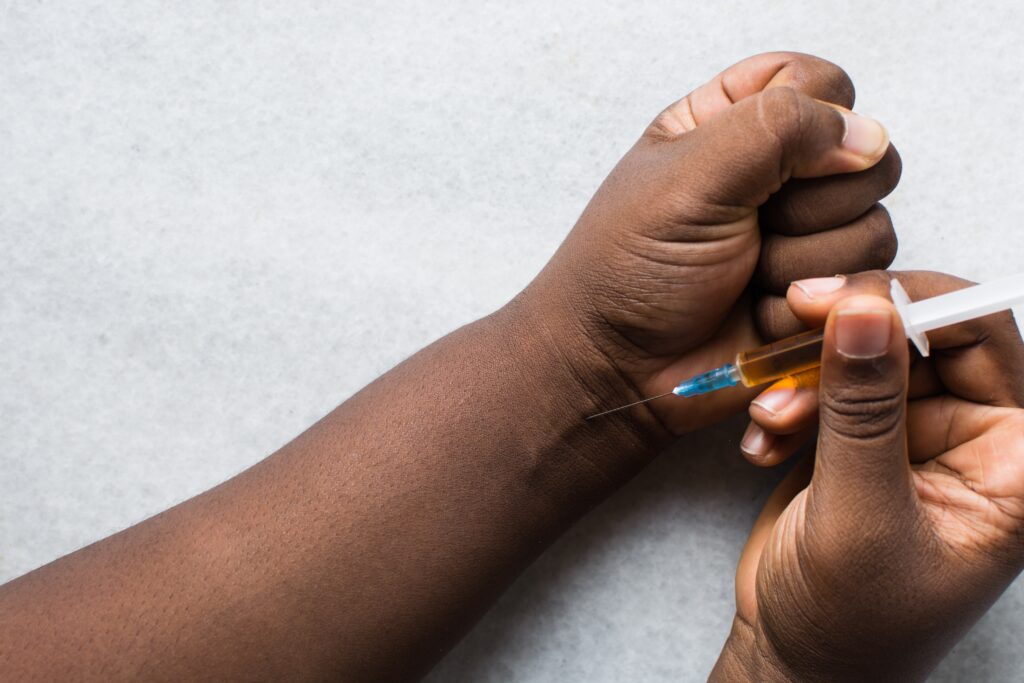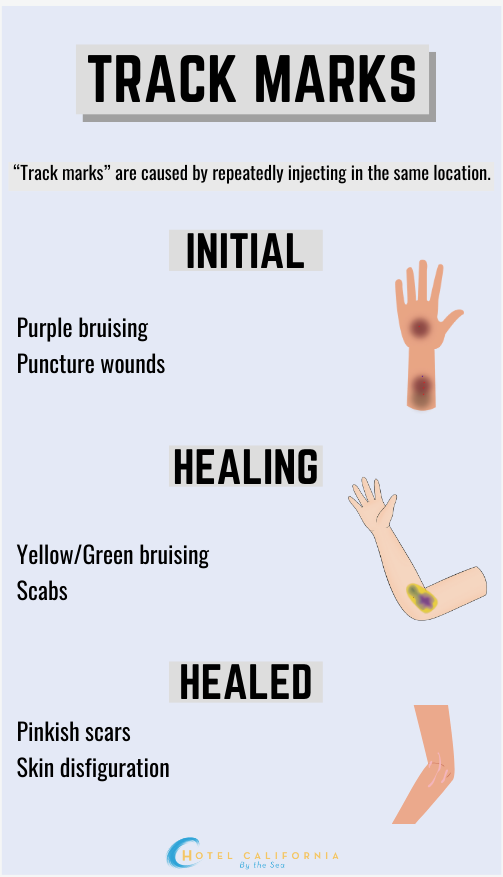What are Track Marks?
Track marks are a series of needle or small puncture wounds across various areas of the body that typically indicate drug use. It is most commonly seen in more severe substance addictions. Track marks are a sign of intravenous drug use and are known as needle marks, injection marks or puncture marks. Puncturing the skin and veins repeatedly over a long period of time causes, bruising, collapsed veins, discoloration, scabs and the development of scar tissue at and around the injection site creating what can look like “track marks” on the skin.

With the current opioid crisis, it has increased the incidence of injection use and injection-related complications. More and more users are turning to this method of drug use. In turn, more and more users are developing track marks and the risks associated with track marks.
When a user has turned to injecting substances, it is a sign that addiction and drug use have escalated. Track marks are typically found on the arms, hands, legs and feet. In some cases, they can even show up on the toes and on the neck. The most common drugs that are injected are heroin, cocaine, methamphetamine, prescription opioids, prescription stimulants, morphine and fentanyl.
The purpose of injecting the substance directly into the veins is to attempt to achieve a greater and more intense high from the drug. This creates a quicker onset of effects, but also a quicker come down from the high. Some users also opt for injecting the substance directly into the skin (skin popping), in an attempt to have a slower absorption rate of the drug so the high will last longer.
What are some of the causes of Track Marks?
- Chronic drug abuse. After prolonged and repeated injection of substances in the same area, the chances of track marks developing increase. The injection marks become damaged and scars will form in the appearance of line marks on the skin surface.
- Old, used, dull or dirty needles. Using the same needle to inject a substance turns them dull. This can put excess pressure on the vein and lead to even more damage as well as the risk of contracting blood-borne disease.
- Injecting impure drugs. In the case of street drugs, it is rare to find a pure form. Most street drugs are mixed or cut with other ingredients that may be toxic. The build-up of these other toxins can cause a dark color on the track marks to develop.

What are Track Marks and how can they be identified?
Track marks usually show up in rows following the vein in which the user would inject themselves. They are small marks that can look like bruises, small puncture wounds or even scabs. They can be round or oval-shaped and are usually discolored. Injecting oneself in the same area or along the same vein over and over again makes it difficult to heal. This eventually leads to the development of scabs that turn into one long scar along the vein that looks like a line on the skin. This is what is called track marks.
Track marks will look slightly different depending on what stage of healing they are at. A fresh needle puncture will often be pink or bright red and can begin to form a scab around the wound. Older track marks may appear to be scalier in texture, slightly raised and discolored. This is usually when it turns into a scar. Or it can become cracked, reopened and infected.
Track marks on the arms are a common point of injection. It is the easiest way for most users to find a vein. It can cause scabs, redness, inflammation and bruising. Track marks on the hands usually cause redness, swelling, scars and the development of heavily pronounced veins.
Track marks on the legs are another common point of injection. It makes it easier for users to inject themselves. Other areas such as the neck or the dominant arm require assistance from another person, which is why they are less common areas.
Skin popping can also cause track marks on the body. Skin popping is when the user injects substances into the skin or muscle instead of the vein. This can turn into discolored and oddly shaped lumps or bumps on the surface of the skin.
Check Your Insurance Coverage for FREE
Find out if your insurance covers addiction treatment in minutes. We accept most insurance!
Ways to hide IV drug use and Track Marks
Injecting on the arms and legs also makes it easier to hide. Those who have track marks usually wear long sleeves and long pants to cover up their injection sites which have most likely turned into discolored scabs and scars. They will inject in areas that can easily be hidden. They will wear long sleeves and layers of clothing despite it being hot outside. Some users go as far as to not go out in public in order to hide their track marks. Some people choose to inject in different areas of the body to better hide their drug use and not create track marks.
The risks and dangers of Track Marks and IV drug injection
- Skin lesions
- Skin ulcers
- Vein damage – collapsed vein, compromised blood flood and the development of blood clots
- Scarring, redness and irritation of the injection site
- Bruising
- Skin abscesses
- Weakened muscles
- Sores
- Toxic build up of substances in veins, which can spread to lungs, brain and liver
- Skin infections due to injecting in the same area and not cleaning or keeping that injection site clean
- Risk for developing Hepatitis B, C, HIV or other blood-borne illnesses and diseases due to needle sharing, using a dirty needle or using a dull needle
- Endocarditis – a condition in which the heart lining starts to inflame and can lead to heart damage and heart failure
- Thrombosis – a condition in which the blood starts to clot too much in the veins making it difficult for organs to receive enough blood. The decrease in blood flow to the brain can eventually lead to a stroke.
- Chronic venous insufficiency – when blood flow is blocked and the body has a more difficult time getting blood to the feet, hands, and heart
- Accidental overdose
Reach out to Hotel California by the Sea
We specialize in treating addiction and other co-occurring disorders, such as PTSD. Our Admissions specialists are available to walk you through the best options for treating your addiction.
Treatment of Substance Use Disorder
Track marks are one of the signs of serious drug use. Track marks often appear red, and irritated and can become infected and turn into abscesses due to the constant and repeated wound damaging to the same area of the skin and vein. Track marks are most frequently found in the crock of the forearm where it is the easiest to inject as well as easiest to hide.
IV injection in combination with mental health challenges can make it very difficult for someone to overcome their drug addiction. Behavioral health treatment programs addressing substance abuse and co-occurring mental health conditions are the most effective methods for treating addiction. Hotel California by the Sea specializes in treating substance use disorder, alcohol use disorder and co-occurring mental health conditions.
We provide all levels of treatment care including detox with 24-hour medical support, inpatient residential with weekly assessments and outpatient programs such as PHP and IOP. We utilize evidence-proven treatment methods that include CBT, DBT and EMDR therapy. The combination of medication treatments and behavioral therapies has been proven to improve a client’s outcome when treating their drug addiction. Hotel California by the Sea is dedicated to helping all our clients overcome their addiction.
References:
https://www.sandstonecare.com/blog/track-marks
https://zinniahealth.com/substance-use/blog/track-marks
https://www.drugrehab.org/what-are-track-marks
https://definingwellness.com/addiction-signs/heroin-abuse/track-marks/
https://www.rehabcenter.net/heroin/track-marks/
